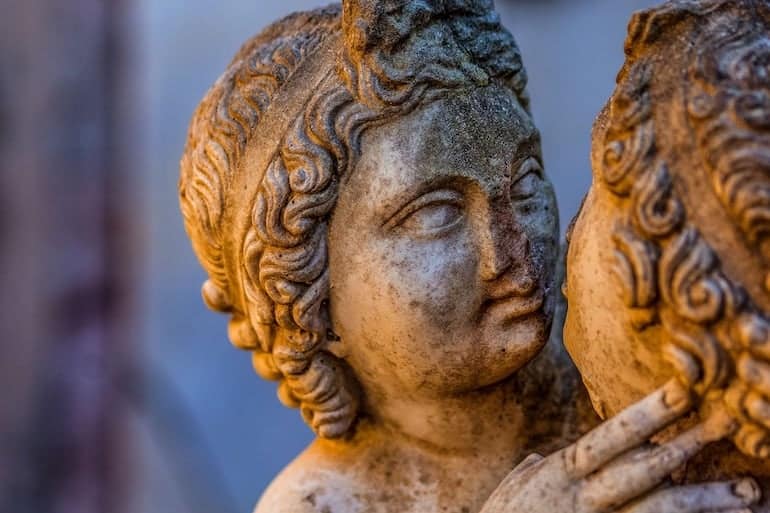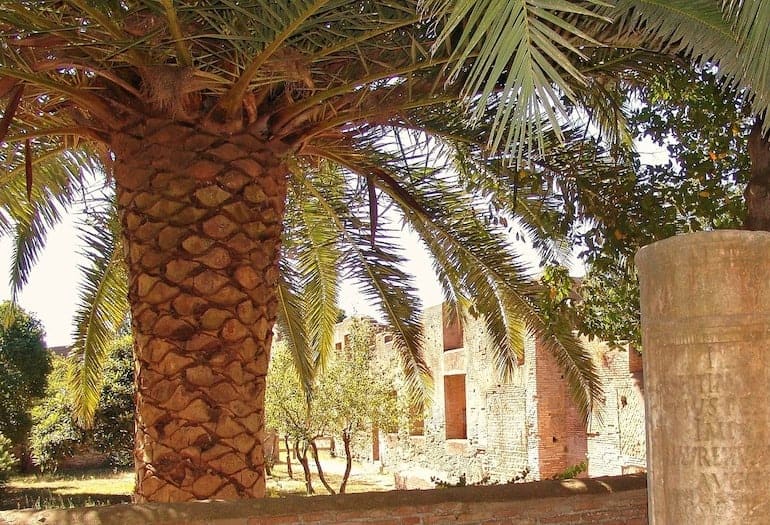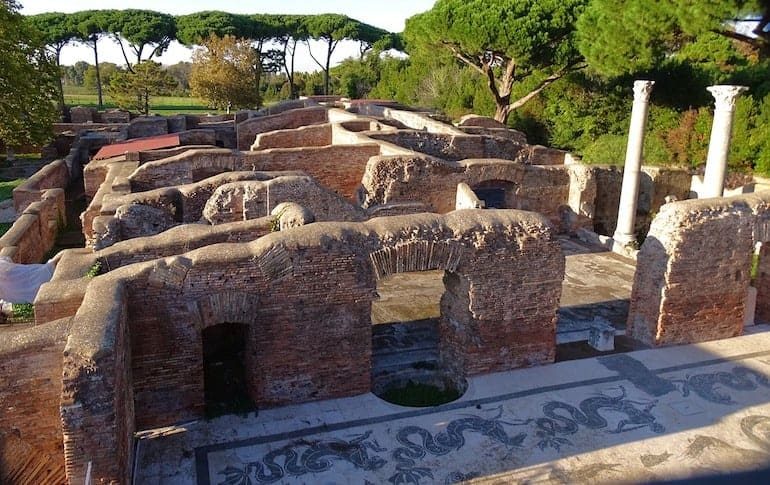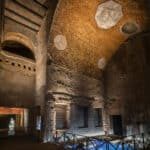A guide to the Ostia Antica archeological park – once a bustling seaport at the mouth of the Tiber River
Instead of trekking down to Pompeii, why not explore Rome’s very own ghost town? Ostia Antica may lack mummified ancient Romans but it is complete with ‘anti-the-man’ graffiti, an amphitheatre and fabulously frescoed villas. This was once a bustling seaport at the mouth of the Tiber River, accepting grain, slaves and innumerable other ‘goods’ from across the Empire. Wandering the amazingly well preserved streets, you’ll marvel at two to three-story apartment blocks, craft workshops, temples, mosaic-laden bathhouses and even a local bar. Given that Ostia Antica receives a tiny fraction of the visitors who flock to Pompeii, at times it feels more like exploring an abandoned movie set than an archaeological site.
From Piramide station (metro B), it takes you only half an hour by train to reach this impressive archaeological site. Once arrived, take a long and leisurely walk and explore the ancient seaport city of Ostia. A walk or tour of this archeological site will give you a unique insight into the everyday life in an ancient city, as well as vividly showing you how the urban space changed and developed over time.

According to ancient tradition, the city of Ostia Antica was Rome’s very first colony and founded during the 7th century BC during the reign of the Tarquinian kings. More likely, the colony of Ostia was established in the 4th century and quickly became an important harbour, which was reflected in the city’s animated building activity.
Since Ostia was a Roman colony and had a similar political and social structure to Rome, you will come across all the landmark buildings that traditionally made up Roman public life: at the forum, there is the capitol, a temple dated to the Hadrianic period and dedicated to Jupiter, Juno, and Minerva. Another highlight is the amphitheatre, constructed by Agrippa under Augustus’ reign, but with numerous additions and modifications over the subsequent centuries.
Today, the theatre is still being used for modern performances during the summer period (https://www.ostianticateatro.com/). The inhabitants of Ostia enjoyed going to the public bath just as much as they did in Rome – make sure not to miss the three well-preserved baths, among which the beautiful Baths of Neptune. Built during the reign of Hadrian, 117 – 138 AD, the bath boasts some beautiful black and white mosaics with depictions of Neptune on his imposing quadriga, putti riding dolphins, and other mythological chimerae.

However, the most striking feature about Ostia Antica are probably the numerous and well-preserved private houses. With houses built between the late Roman Republic and the 4th century AD, Ostia Antica provides some impressive examples of the architectural history of ancient Roman homes, while the beautiful surviving interior decoration, such as mosaics and wall-paintings, will make your journey to antiquity even more vivid. Highlights include the House of Jove and Ganymede which, together with other houses and apartments, formed part of an apartment block, a so-called insula. Constructed in the Hadrianic period, the house is home to several mosaics, as well as well-preserved wall paintings in one of the main rooms showing Jupiter and Ganymede, Greek philosophers, as well as architectonic elements such as columns, all painted in rich colours. For a later example, go see the House of Cupid and Psyche, dated to the late antique period. Wall painting had been out of style by then, instead, the House of Cupid and Psyche contains impressive marble wall decorations, beautiful opus sectile and mosaic floors, as well as a statue of the name-giving Cupid and Psyche in one of the rooms.
If you still have enough energy after your tour, Ostia Antica is also home to a museum boasting even more impressive archaeological finds, while there is also a cafeteria for those who want to have a snack and relax.
Address
Via dei Romagnoli, 717 – Ostia Antica
Opening hours and entry fee
Tuesday – Sunday 8.30am – 7.15pm (from the last Sunday in March to August 31st)
Tuesday – Sunday 8.30am – 7pm (from September 1 – 30)
Tuesday – Sunday 8.30am – 6.30pm (from October 1 to last Saturday of October)
Tuesday – Sunday 8.30am – 4.30pm (from the last Sunday of October to February 15th)
Tuesday – Sunday 8.30am – 5pm (from 16 February to 15 March)
Tuesday – Sunday 8.30am – 5.30pm (from 16 March till last Sunday of March)
Full price entry: €8
Info





